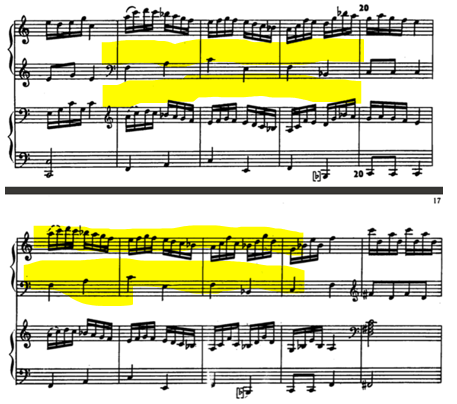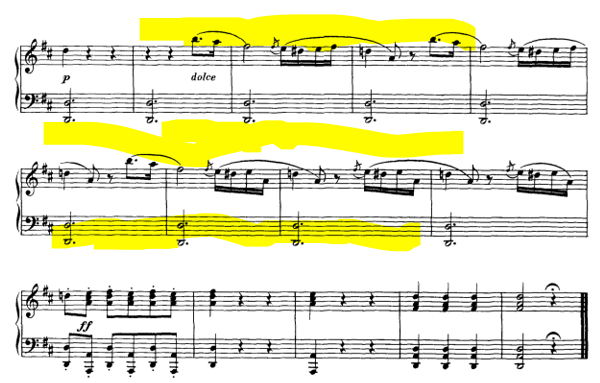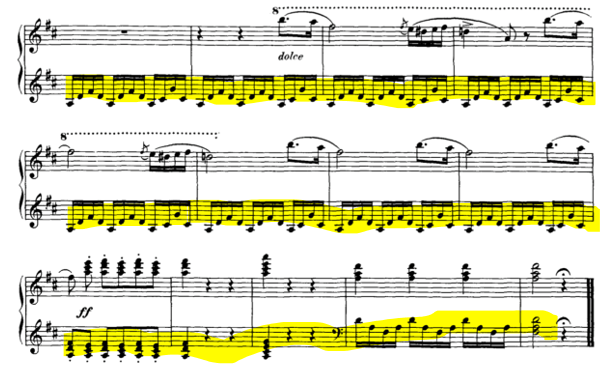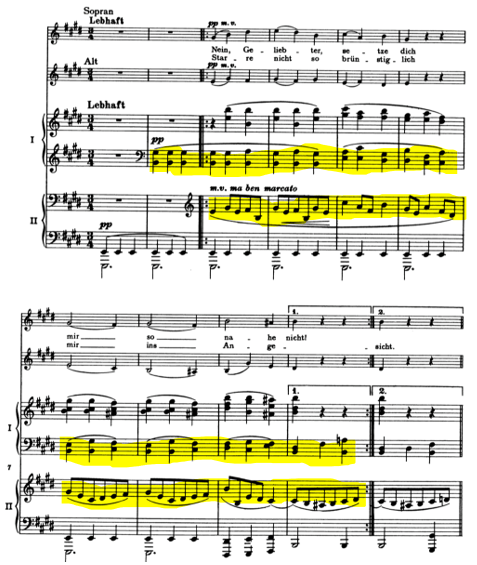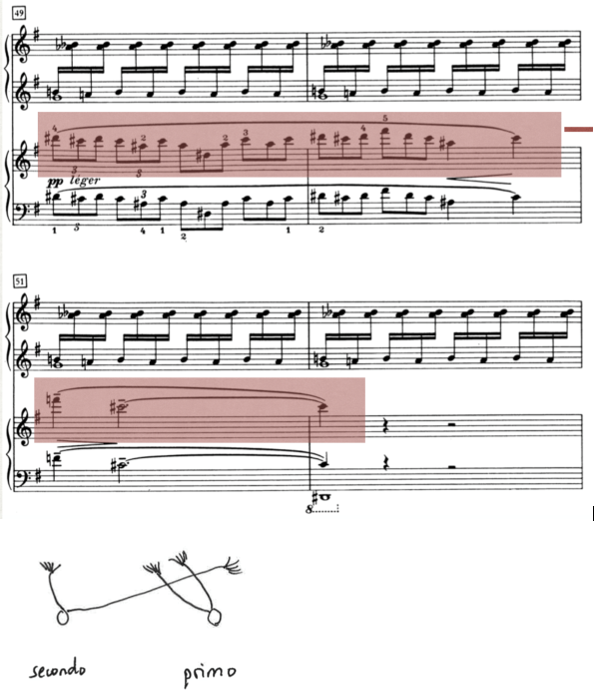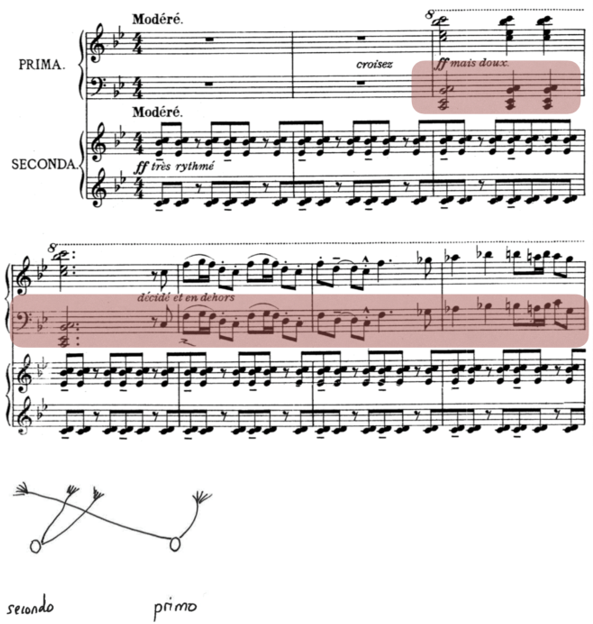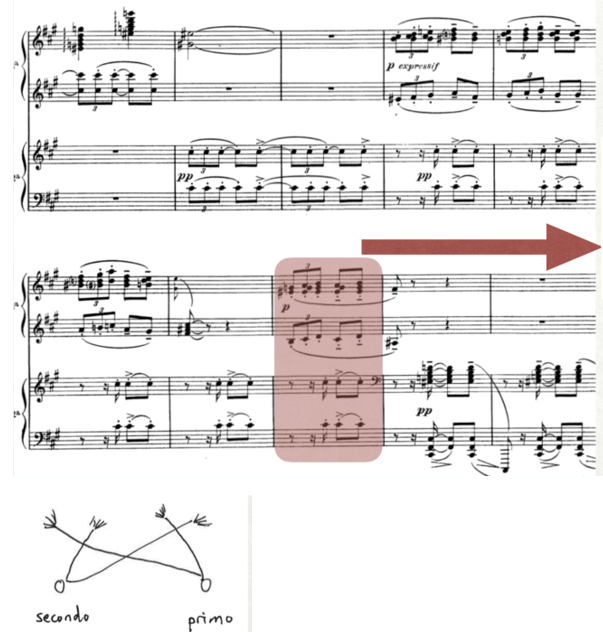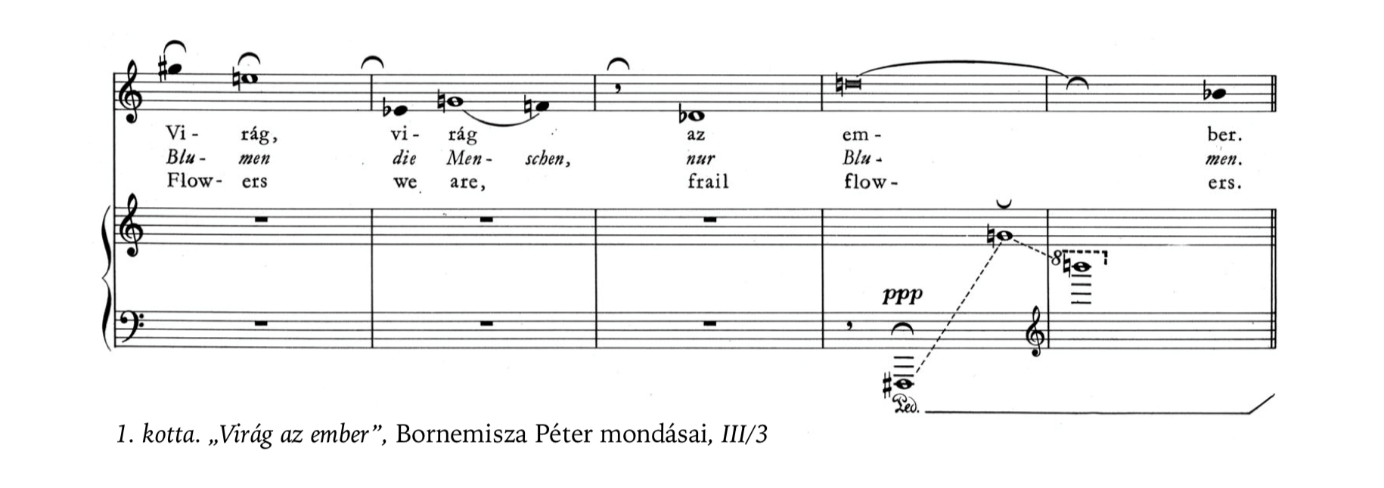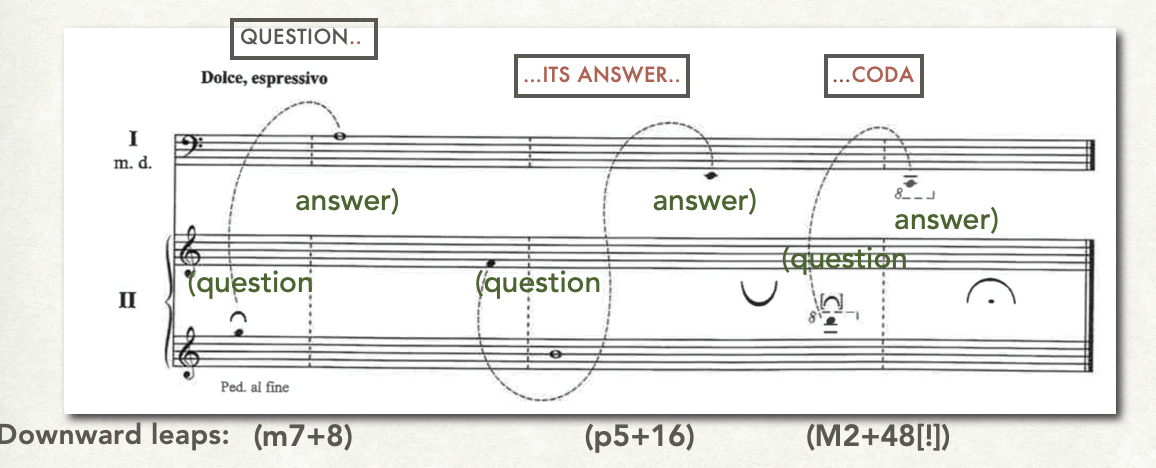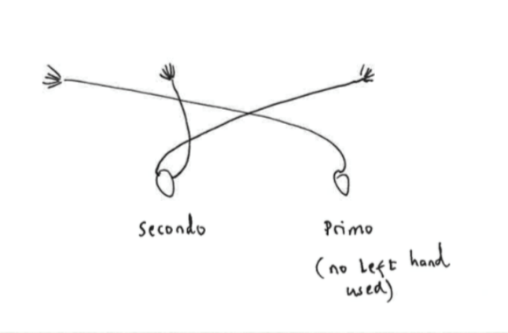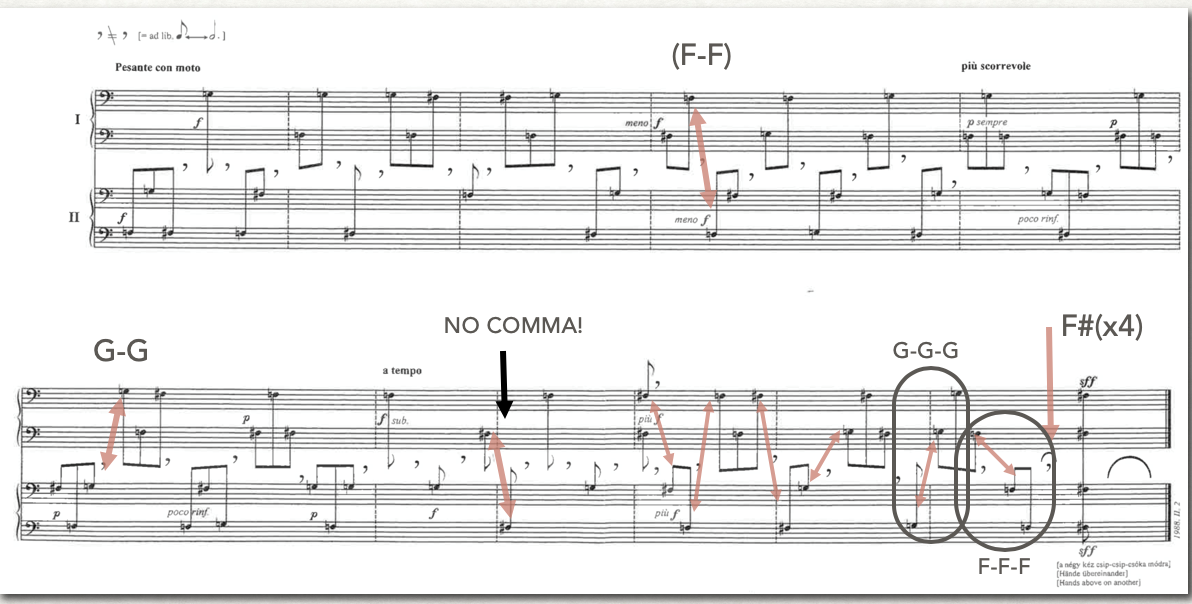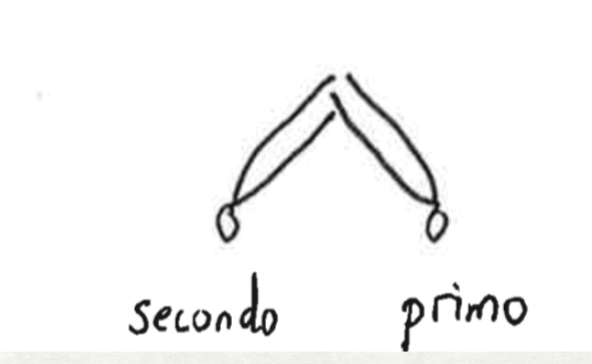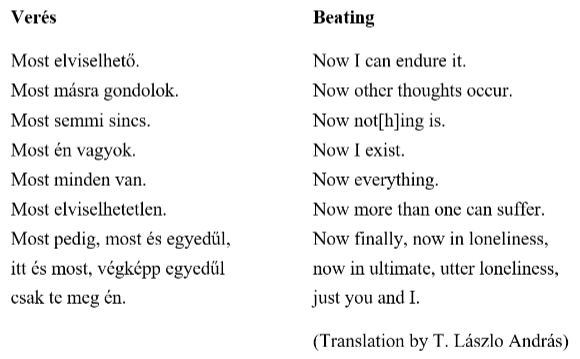From Four-handed Monster to All-embracing Vishnu: the Case of “Middle Hands” within a Piano Four Hands Duo
Read as PDF
Table of Contents
DOI: 10.32063/0511
Cecilia Oinas
Cecilia Oinas is a Finnish-Hungarian music scholar, music theory lecturer, and a classical pianist from the University of the Arts Helsinki (Sibelius Academy). In 2017, she completing her doctorate in the Sibelius Academy’s DocMus department, in which she examined the Mendelssohn and Schumann piano trios with the special aim of combining aspects of analysis and performance in a symbiotic way: performance being influenced by analysis and analysis by performance. She was subsequently appointed to a post-doctoral research post at the University of Music and Performing Arts Graz (2018–2019).
Cecilia’s research interests lie in performance studies and interdisciplinary research, as well as in combining aspects of music analysis and performance in a chamber music context. She has published peer-reviewed articles and given presentations and lecture recitals in numerous seminars and conferences in Europe and the US. She is also an active pianist, specialising in chamber music and collaborating with classical singers.
by Cecilia Oinas
Music & Practice, Volume 5
Instrumental Genre & Corporeality
Introduction
Depending on whom you ask, playing piano four hands is either a merry social event, where two pianists play together in an impromptu manner, or one of the most challenging forms of chamber music to play well and with perfect coordination. While there have been studies about the social significance of piano four hands music in amateur music-making in the long 19th century (see Daub 2014; Christensen 1999 and Adorno 1933), there are relatively few that have considered the art of four-handed playing at the professional level (however, see Haddon and Hutchinson 2015). Moreover, in light of the more recent discussion of performance studies and performativity (Kartomi 2014; McRae 2015), four-handed piano music presents a fascinating dichotomy between private and public performance construction. On the one hand, it has often been described as a fairly private medium, played in bourgeois households by amateur musicians throughout Europe and America (Christensen 1999; Daub 2014). On the other hand, if there is any kind of audience – even on private or semi-public occasions – seeing two people playing within such close proximity to one another may put the audience in a position that could even be perceived as voyeuristic (Cone 1974; Daub 2014). As Adrian Daub writes:
What two people do on one instrument is never fully private, and their activity tended to be viewed accordingly. But if four-hand players encouraged spectatorship, they also shut out spectators far more radically than other forms of Hausmusik.[1]
The aim of the present article is to examine the particular challenges of four-handed playing, especially the question of the so-called “middle hands” – that is, primo’s left and secondo’s right hand – that are in close contact with each other in performance and, as a result, often require particular attention.[2] The problem of the middle hands is unique when compared to that of any other chamber ensemble and thereby something worth examining in more detail. Furthermore, investigating four-handed works from this tactile viewpoint enables us to find common ground between different musical styles and periods: from Mozart’s late 18th-century works to György Kurtág’s miniature four-hand pieces in Játékok IV and VII.
My goal is therefore to acquire a more holistic view of the phenomenon of playing piano duets, a genre that, until recently, has not been excessively studied from a performative point of view. Along with examining four-handed works, I have interviewed eight professional piano duos about their thoughts on playing four-handed music, especially concerning their management of the inner hands. The interviews were done by sending a semi-structured questionnaire via email between October 2018 and January 2019. Selected responses from six duos have been used in this article. My hope is that, by flexibly navigating between aspects of performance research and music analysis, I have been able to “incorporate […] the contributions of the performing body and its ways of knowing music”, as well as “the effects of the dynamics between the performer and the audience into their explanatory structures”, as recently suggested by Mine Doğantan-Dack.[3]
Background
For the composer, one of the advantages of writing four-handed piano music (in comparison with solo piano music) is the possibility it gives for textural expansion and the creation of legato lines in multiple registers. However, from the performers’ perspective, pianists playing this repertoire need to deal with the physical restrictions that come from two players addressing the same keyboard, especially when it comes to the movements of the middle hands. This can be seen in the following video clip by the Shelest Piano Duo where, while the outer four-handed arms are able to make larger gestures, the middle hands are quite constrained. The duo is playing Ravel’s La Valse (in the arrangement for four hands)
Video 1
The video evokes Edward T. Cone’s famous notion of the so-called “four-handed monster”, referring to the idea that the two players need to blend together as one musical persona with four hands, as opposed to participating in an interaction between two still separate agents.[4] This has implications for how four-handed piano music must be rehearsed, with the players taking into consideration how best to work around one another while each executing the requirements of their individual part. In the video we can see that the hand movements have been consciously planned and coordinated between the duettists in such a way that the arm and torso movements do not disturb the other partner’s playing. The idea that middle-hand movements had to be specifically rehearsed and choreographed was also verified by the replies of the piano duos who were interviewed:
It is one of the issues in the rehearsals to organize the space in order to avoid “traffic jam” on the keyboard. Who plays up, who down etc.? […] The principal voice, sometimes also the technically more difficult one, has to feel as comfortable as possible. (Duo A, playing together for 20+ years)
We will decide who goes “in” towards name-board, and who goes “out”. We often re-arrange parts too. […] We give primacy of comfort to primo – secondo can more easily accommodate uncomfortable positions in RH [right hand], and prominence of primo part musically tends to encourage more affordances. (Duo E, playing together for 15+ years)
An extreme reply was made by one duo, who wrote: “Every movement is calculated!” (Duo C, collaborating for 15+ years), yet there was also a duo who responded that: “We don’t plan consciously. But usually the hands still go well together.” (Duo F, collaborating for 30+ years). The answers may reflect the physical differences between duo partners, such as larger male/more petite female duos that often require different choreographic solutions than those between two female duettists, for example. To be able to fit together comfortably over one keyboard remained one of the central topics in many of the replies to the questionnaires, along with other practical issues such as pedalling and balancing, which are also very different when compared with solo piano playing.
In the next section, I will go into the middle-hand question in greater detail by considering moments when the middle hands criss-cross over one another, thereby creating an interchange of hands within the duo that affects the playing experience on many levels.
Embodied aspects of duo playing: middle-hand interchanges
A special case involving middle-hand choreography occurs during moments in which the middle hands occasionally interchange their position. As can be seen in the painting by Johann Nepomuk della Croce of the two Mozart siblings, Wolfgang and Nannerl (the family nickname for Maria Anna), and their parents, works in which the middle hands interchange are already found in the late 18th century. There are purely musical reasons why a composer might choose this tactic. For instance, Howard Ferguson writes that “a change in distribution is bound to produce a change of tonal balance, not only between the hands of each individual player but also between two partners”.[5] Nevertheless, it also provided a closer physical contact between the four-handers, sometimes not only seemingly for the sake of music.[6] Ernst Lubin notes that “perhaps it is more than a mere accident that so much piano duet music involves a crossing of the hands between the partners, even where it may not be absolutely required by the music itself”.[7]
It may come as a surprise, however, that with Mozart, the only four-handed work that does include criss-crossing is his early Sonata K. 19d in C major from 1765 (Ex, 1). As Lubin notes, “It is hard to say whether the 8-year old Mozart was aiming at a change in tonal balance when he made primo and secondo cross hands in the finale of his Sonata C, K. 19d, or whether he was more concerned with astonishing his London audience”.[8]
The fact that Della Croce has chosen to depict the hands interchanging in the painting does reveal something about the embodied aspect of it – perhaps also about power structures, as Wolfgang is both providing the bass and putting his right hand over Nannerl’s left hand. While, in this instance, the players are family members, the potential moral precariousness resulting from the close proximity of colliding fingers was widely noted in the art and literature of the nineteenth century. For instance, in Charles de Bernard’s novel Gerfaut from 1838, the secret lovers meet and start to play a waltz together. But the man only plays the bass part with his left hand, and the lady the primo part melody with her right hand. The narrator in Bernard’s novel then asks archly: “Well, what could two such underemployed hands directly next to each other do?”.[9]
In many 19th-century four-hand works, the middle hands are in close contact with each other, sometimes even playing the same notes one after the another; yet genuine written-down middle-hand interchanges do not occur that often in works by notable four-hand composers such as Schubert, Weber, Felix Mendelssohn, or Robert Schumann. With Schubert for instance, middle-hand interchanging is found only briefly and in just two of his works: The Fugue in E minor (D.952) and in his early Rondo in D Major (D. 608) from 1818 (Ex. 2):
Secondo:
Primo:
Rare as they may be, these instances are not in any way accidental and they evoke a sense of bonding that can be experienced only when playing through the piece – or if looking at two people playing it. As Philipp Brett writes:
How much quicker might Tolstoy’s Pozdnyshev have murdered his wife if the sensually marked musician he invited into the household had played, rather than Beethoven’s “Kreutzer” Sonata, Schubert’s Rondo in D, at the climax of which the four hands interweave?”.[10]
In second half of the 19th century, composers such as Brahms and Dvořák used middle-hand interchanges more frequently. This is particularly evident in Dvořák’s Slavonic Dances Opp. 46 and 72, Brahms’s Hungarian Dances Nos 4 and 18, and Brahms’s Neue Liebeslieder No. 14 (1875). In the latter instance where words are added into the mix, the protagonist even says, “Nein, Geliebter, setze dich mir so nahe nicht!” (No, beloved, do not sit so close to me!), perhaps a practical joke by Brahms for the benefit of the “Kattermäng” players – his own little word-play on the French “quatre mains” (Ex. 3).
Towards a new tonal balance: middle-hand layering in French music
Although the musical and extra-musical implications of physical proximity between duo partners were noted in art, literature and philosophy throughout the 19th century, it was only in the early 20th century that French composers began to explore new and imaginative ways as to how the four hands could be distributed. Three hallmark works of this kind are Debussy’s Six épigraphes antiques (1915) Ravel’s four-handed version of Rapsodie espaganole (1917), and Poulenc’s Sonata for four hands (1918). Below are just a few examples that I have collected, together with my own (handwritten) drawings on hand distribution:
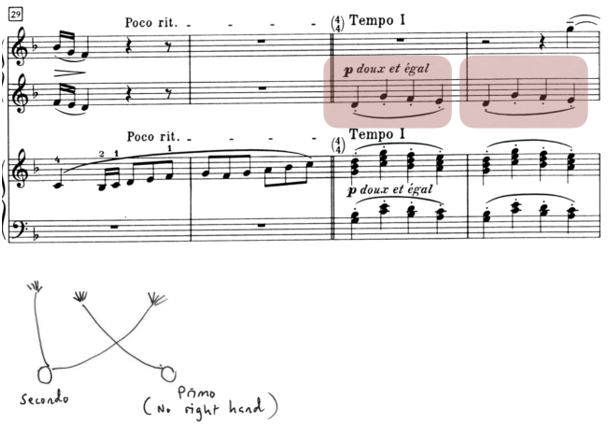
Example 4a Claude Debussy: “Pour invoquer Pan, dieu du vent d´été”, from Six épigraphes antiques (1915), mm. 29–32

Example 4b Debussy: “Pour invoquer Pan, dieu du vent d´été”, from Six épigraphes antiques, solo piano version (1916) maintains hands criss-crossing over the same measures (31–32)!
In Debussy’s “Pour invoquer Pan, dieu du vent d´été” from 6 épigraphes antiques (Ex. 4a) the primo’s left hand takes part in the chordal progression by playing one line between the secondo’s right and left hands. This merging is a particularly delicate one and enables the d-g-f-a melodic line to stand out in both octaves. Interestingly, even in the solo piano (Ex. 4b) version arranged by Debussy the following year, the two hands maintain the criss-crossing, as Debussy wants to include the four-handed merging into the solo piano version as well.
The example above is from the final movement of the 6 épigraphes, “Pour remercier la pluie au matin” (Ex. 5). Here the secondo plays the melodic line in two registers, one above and the other below the primo, who plays the dreamlike, mechanical sixteenth-note motion throughout almost the entire movement. In contrast, Poulenc’s beginning to his Sonata (Ex. 6) is almost the complete opposite since it is the primo who plays the theme, with its crashing opening chords and circling folk-like consequent phrase. This is sounded out in parallel motion, four octaves apart, above and below the secondo’s more tightly bunched ostinato-based rhythmic accompaniment. The movements of the primo’s left-arm, as it reaches into the depths of the bass register, must be choreographed wisely throughout this opening, with its Sacre-like rhythmic pulsations, otherwise there is a real danger of collision (as this author can testify, having once caught the nose of her secondo partner during the execution of these bars!).
The most complex example (Ex. 7) is from the third movement, “Habanera”, of Ravel’s Rapsodie espagnole. It requires all four hands to be interchanged. I call this the “double interchange”. While it is written quite conveniently from a pianistic standpoint – the secondo, who plays the “habanera” rhythm, may play their part in an almost vertical hand position – it indeed requires a precisely synchronized playing style to maintain comfortable playing. The original version from 1895 was for two pianos, which partly explains the numerous crossings. Video 2 shows a performance by Piano Duo Gerwig and González from 2006.
Video 2
Are these interchanges made solely to create nuanced or delicate changes in “tonal balance”, as proposed by Ferguson? Perhaps partly; but, at the same time, they also enable players to merge into one persona, rather than being, as Daub writes, the “songbird”-like primo and the “accompanist”-like secondo that was more customary in 19th century four-handed works.[11] This persona, however, is not so much of a “monster” but more like a tender four-handed, all-embracing Vishnu who carries the musicians from one bar to the next. Moreover, in the “Habanera” the middle-hand interchange has been extended to the duo’s outer hands (primo’s right and secondo’s left). It is these four-hand qualities to which I should now like to turn in my final section on Kurtág, the four-hand composer par excellence of contemporary music.
In contrast to most contemporary composers, the Hungarian György Kurtág (b. 1926) has explored the piano duo genre numerous times in his piano work collection Játékok (translated as Games in English). Two of these, IV (1979) and VIII (1984–2005, published in 2010), are dedicated exclusively to piano duos, both four hands and two pianos.[12] With such a vast assortment of four-handed music, Kurtág’s works present an interesting research topic, both in-and-of themselves and as a point of comparison to the four-handed writing style and performance tradition of the long nineteenth century.
I will now examine two four-handed works by Kurtág, “Flowers we are…[embracing sounds]” and “Beating – Quarrelling”. More precisely, I am interested in how Kurtág’s distribution of primo and secondo parts creates a private, even intimate, space for the pianists – something that is not necessarily audible or apparent om the score alone but is keenly perceived by the performers themselves. For instance, while in “Flowers we are …” the hands are distributed in a highly unorthodox way throughout the piece, this distribution is by no means necessary in order to play the published notes. In fact, the work could easily be rendered in a more traditional way where primo and secondo roughly divide the keyboard above and below middle C. As a counter-example to the pliable “Flowers we are…”, in “Beating – Quarrelling” the composer pushes the limits of physical proximity to an almost intolerable point where four hands are instructed to play the same note above one another. This requires precise timing and corporeal synchronization but, most of all, empathy and trust, which, according to Elizabeth Haddon and Mark Hutchinson, are key aspects in being able to play four-handed music successfully.[13]
Below is a video clip where Kurtág and his wife Márta Kurtág are playing “Flowers we are …”. This clip is from a concert held in 2012 at Cité de la musique in Paris.
Video 3 György and Márta Kurtág perform “Flowers we are…[embracing sounds], 2012
The performance offers an example of two musicians, a couple in real life for many decades, sharing the same keyboard in a sensitive and mutually appreciative way. It seems that, inside the great hall, the couple is creating its own “safe space” where the hands will meet and touch – sometimes on the keyboard, and at other times off the keyboard.[14] Yet from the point of view of four-handed piano writing, the choice of primo and secondo distributions seems to be in direct contrast with their typical roles, since it is the primo who plays the lower and secondo the higher notes of the keyboard. What, then, are Kurtág’s intentions regarding the criss-crossing of the hands and torso? What would be the difference if the musicians were to play it in the way that is written in my “recomposed” version?
Video 4 Performance of “Flowers we are…” without hands interchange (Oinas & Parko 2019)
Both external and internal reasons explain the intentional criss-crossing. For instance, according to Anna Dalos, the original version of “Flowers we are…”, as found in the work entitled The sayings of Péter Bornemisza for soprano and piano from 1968 (Ex. 8a), is a paradigmatic example of Kurtág’s so-called “periodic form”. It consists of a question (first gesture) and an answer (second gesture), followed by a coda (final gesture).[15]
In the four-handed version (Ex. 8b) the question-answer play can also be seen within each gestural exchange between the secondo and primo parts.[16] Moreover, with each subsequent question-answer, registral distance is increased, ultimately resulting in leaps that span the entire width of the keyboard from the highest D to the lowest C. As noted by Dalos, Kurtág composes his works in such a way that he is already anticipating audiences’ reactions in (live) performances.[17] This registral spanning within the conversation becomes visually more apparent with the unusual hand distribution (Ex. 8c), which almost forces the audience to become engaged sympathetically and quasi-physiologically as the two pianists become physically intertwined during this brief work.
Video 5 Performance of “Flowers we are…” (Oinas & Parko 2019)
But does the hand distribution have any noticeable effect on the outcome in terms of the sound? In her studies of Kurtág´s piano pedagogical approaches, Kristiina Junttu (2008) has examined Játékok, including a discussion of the solo piano version of “Flowers we are…”, found in the first volume. According to Junttu, “despite the approximate notation, Kurtág is very accurate with the quality of expression. Spiritual, physical and gestural dimensions are brought to the fore”.[18] She also writes that Kurtág has advised the pianists to play the lower staff with the right hand and upper staff with the left hand in order to create the maximal kinaesthetic effect and the sensation that the melody flows through the body.[19] Seen in this light, it is only logical that in the four-handed version, Kurtág equally stretches the maximal effect by distributing primo and secondo parts in a more unusual way. Furthermore, Kurtág’s notation, with its relative rather than definitive duration, enables the performers to be in the moment, to be able to feel rather than to count when the precisely right time is to play the subsequent tone.
A different type of corporeal interaction between the performers is seen in “Beating – Quarrelling”. Quite remarkably, only three notes are played in this entire piece: F natural, F sharp, and G natural, all in the same register (Ex. 9). There is a sharp dichotomy between, on the one hand, being polite by dodging your hands away before the duo partner plays her part and, on the other and as the title of the piece seems to suggest, fighting for your territory! In performance, there is indeed an occasional danger of striking the fingers of your duo partner during these three-note gestures.
In the score above, I have marked all the instances where pitches are repeated between the pianists. In the first two, the comma enables the hand-dodge to take place quite comfortably, but after the a tempo instruction in the second system, for the first time there is no written comma between the primo and secondo entrances, which means the other player needs to move their hands away very quickly. In the final moments, there are even three repeated notes, G-G-G and F-F-F, until the piece ends with the final F sharp unison, which is preceded by a prolonged comma.
Video 6 performance of “Beating – Quarrelling” (Oinas & Parko, 2019)
It may be observed how, in our video, the eye contact between the duettists happens more frequently than in a typical four-handed performance. Visually speaking, it enhances the concept of an agitated and, to some extent, comic dialogue, which culminates in the four-hands-over-one-note ending. Although from a purely acoustical point of view, it is probably insignificant whether or not only one of the four hands hand would actually play the final F sharp, within the context of performance this is the entire point of the piece.
While I have been talking about “Flowers we are…” and “Beating – Quarrelling” as examples of Kurtág’s four-handed music, we may find ourselves asking whether we are aling with genuine four-handed works in the first place. Tellingly, in one of the recordings of this work, the subtitle of “Flowers we are…[embracing sounds]” states: for three hands (my italics). It is also clear from Kurtág’s score that it is the primo’s right hand and both of the secondo’s hands that are required to play. In “Beating – Quarrelling”, Kurtág’s notation instructs that all four hands be engaged in this artificial combat despite the fact that the notes could, in reality, easily be played by three or two hands or even one on its own. Yet from a performative point of view, each rendition would produce a different result, and, in some way, a completely different work.
Regarding the character of the pieces, it is interesting that both of Kurtág’s works originate from vocal settings: as noted earlier, the precursor for “Flowers we are…” is found in The sayings of Péter Bornemisza for soprano and piano. This four-movement, fiercely difficult, work includes texts by Péter Bornemisza, a Hungarian bishop and playwright who lived in the 16th century. The text, “Flowers we are”, is found in the third movement, evoking the idea of fragility after vividly describing the horrors of dying in pain. Meanwhile, the vocal source of “Beating – Quarrelling” is from Four songs to poems by János Pilinszky for baritone and chamber orchestra (1973–75). Pilinszky (1921–1981) was one of the most important post-war poets in Hungary and also Kurtág’s personal friend. After reading Pilinszky’s poem “Beating” (Kráter, 1974–75), shown below in both the original language and its English translation, the seemingly humorous character of the four-handed version is at least put into a different perspective owing to the more serious nature of the poetic text (Ex. 11). The paradox of two individuals isolated from the rest of existence – “just you and I” – but simultaneously each in “ultimate, utter loneliness” (i.e. isolated from one another) is vividly echoed in the musical metaphor of the two pianists, both occupying the same space and constantly displacing one another. In the poem, each line goes over the same situation in a circular manner but always with a new introspection or reaction by the protagonist. In its reiteration of the Hungarian word “most” (English “now”) the poem also remains very much in the present, as if the situation is happening in real time.
In Kurtág’s case, the recycling of previously composed material through the use of references and signs of homage to other works of his is an integral part of his compositional style (see, for instance, Bleek 2017). Thus, it does not necessarily mean that the original character is specifically present in the new version. However, I propose that by arranging these previously written works in a four-hands version, a new level of intimacy and corporeal awareness, or, as Thomas Christensen writes, a “tactile dimension” is reached.[20] At the same time, Kurtág resurrects the almost long-lost four-handed tradition, complete with hands interchanging, experimenting with different sonorities and different renditions of tonal balance.
Conclusion
Two quotations sum up much of what has been said above:
Without the audience’s shared knowledge of the performance conventions and its enthusiastic attention to happenings in the stage arena, a performance cannot be judged a success, or—arguably—even be regarded as a proper performative event.[21]
The eroticism of playing four-hands lies in the back-and-forth between this moment of fulfilment and the moment of self-denial. At times, it seems as though even the players cannot be altogether sure which of them is producing which note.[22]
Because four-handed music is the only genre in which we encounter physical sensations not only by touching the instrument but also by sensing the physical presence of our duo partner, playing four-handed works requires a heightened level of corporeal coordination in order to enhance the effectiveness of the performance. At the same time, the intimacy of music-making in four-hands music is one of the factors that make it so addictive to duettists. This was reflected in the piano duo’s responses when they were asked, “What is the most rewarding thing in four-handed music”: —
It is very intimate; you really must become one living organism. In challenging pieces […] one can feel this connection. Also, you are more in contact with the partner, the distance and timing because of distance is not an issue, you are truly creating one unity, breathing together. (Duo C)
The proximity allows for very close coordination. The accumulation of sound and variety of timbres that can be created is also very powerful and rich. (Duo D, playing together 20+ years)
The repertoire itself, and also the sense of unity and becoming one, yet playing with freedom that can come with experience and effort. (Duo E, playing together for 15+ years)
The intimacy, that you only can get otherwise (I imagine) in a string quartet. It is the only setting, where two persons make sound on one single instrument. This is and remains a challenge, but when it works, it is extremely rewarding! (Duo A)
I propose that the fluidity of roles in middle-hands interchanging enables the duettists to accomplish something that Rabinowitch, Cross, and Burnard, in their study on musical group interaction, called “merged subjectivity”.[23] In other words, the fusion of hands, in which even the players themselves may not be sure who is playing, can enable the players, as Haddon and Hutchinson write, “to make decisions as a unit and even to experience each other’s senses as their own”.[24]
To conclude, my article suggests that, in many instances, middle-hand interchanging and other unorthodox hand distributions do not come out of purely practical needs. Rather, there are occasions when they help to create a special, corporeal link between the two pianists. For instance, I argued that, in many of his four-handed works, Kurtág is playing (or “gaming”), with the performative aspect of four-handed music, as opposed to the actual need for four hands.[25] Yet this performativity does not only exist in an extroverted, audience-dependent context. While “Beating – Quarrelling” at first seems to contain highly extroverted performativity, this apparent extroversion becomes more complex and paradoxical if we take into account Pilinszky’s poem, with its central idea of “two people” alone together, and see the keyboard in Kurtág’s creation as the metaphysical battlefield upon which they contest their solitary togetherness. “Flowers we are…”, goes even further by containing something that I would rather describe as “introverted performativity”, kept within the duo’s own dynamic and corporeal interaction. In order to approach these questions, musical analysis alone is not enough; it becomes essential that we include in our inquiries the special artistic expertise and the tactile, corporeal elements that make four-handed piano music so distinct from any other chamber music genre.[26]
Bibliography
Adorno, Theodor, “Vierhändig, noch einmal”, 1933, reprinted in Theodor Adorno, Impromptus, (Frankfurt: Suhrkamp, 1968) pp. 142-5
Brett, Philip, “Schubert and the Performance of gay Male Desire” in 19th-Century Music, Vol. 21, No. 2, 1997, pp. 149–76
Bleek, Tobias, “‘Das Geschriebene darf nicht ernst genommen warden – das Geschriebene muß todernst genommen werden’. Zur Notation und Interpretation musikalischer Gesten im Schaffen György Kurtágs” in Zeitschrift der Gesellschaft für Musiktheorie, Vol. 14. No. 2, 2017
Christensen, Thomas, “Four-Hand Piano Transcription and Geographies of Nineteenth-Century Musical Reception”, in Journal of the American Musicological Society, vol. 52, No. 2, 1999, pp. 255–98
Cone, Edward T., The Composer’s Voice, (Berkeley & Los Angeles: University of California Press, 1974)
Cook, Nicholas, Beyond the Score: Music as Performance, (New York: Oxford University Press, 2013)
Dalos, Anna, “Kurtág, az elemethetetlen. Analitikus utak az elsö, avantgárd korszak ételmezéséhes (1957–1962).” [“Kurtág – the Composer whose Music Cannot be Analysed. Analytical Ways Towards the Interpretation of the First Avantgarde Period (1957–1962)], in Magyar Zene folyóirat [in English: Hungarian Music Quarterly], 2012/1, pp. 91–107
Daub, Adrian, Four-Handed Monsters: Four-Hand Piano Playing and Nineteenth-Century Culture, (Oxford: Oxford University Press, 2014)
Doğantan-Dack, Mine, “Once Again: Page and Stage” in Journal of the Royal Musical Association, Vol. 142, No. 2, 2017, pp. 445–60
Ferguson, Howard, Keyboard Duets, (Oxford: Oxford University Press, 1995)
Haddon, Elizabeth & Mark Hutchinson, “Empathy in Piano Duet Rehearsal and Performance” in Empirical Musicology Review, Vol. 10, No. 2, 2015, pp. 140–53
Junttu, Kristiina, “György Kurtág’s Játékok brings the body to the centre of learning piano.” In Musiikkikasvatus, vol. 11/1–2, 2008, pp. 97–106
Kartomi, Margaret, “Concepts, Terminology and Methodology in Music Performativity Research” in Musicology Australia, Vol. 36/2, 2014, pp. 189–208
Leech-Wilkinson, Daniel, “Compositions, Scores, Performances, Meanings” Music Theory Online, Vol. 18, 2012, No. 1 (http://mtosmt.org/issues/mto.12.18.1/mto.12.18.1.leech-wilkinson.php)
Lester, Joel, “Performance and analysis: interaction and interpretation” in John Rink, ed., The practice of performance, pp. xx-xx. (Cambridge: Cambridge University Press, 1995), pp. 197–216.
Lubin, Ernest, The Piano Duet. A Guide for Pianists, (New York: Grossman Publishers, 1970)
McRae, Chris, “Hearing Performance as Music” Liminalities: A Journal of Performance Studies, Vol. 11, No. 5, November 2015
Interviews
Eight Duos, labelled as “Duo A” to “Duo H”, replied to via semi-structured email questionnaire between October 2018 and January 2019
Endnotes
[1] Adrian Daub, Four-Handed Monsters: Four-Hand Piano Playing and Nineteenth-Century Culture, (Oxford: Oxford University Press, 2014), p. 11
[2] The term “middle hands” is borrowed from Ernst Lubin’s book Keyboard Duets (1970). While the term is not widely used, it is usually something that most performers instantly recognise without further definitions. There are other names used as well, such as Howard Ferguson who calls middle hands as “inside hands” (Ferguson 1995, p. 29).
[3] Mine Doğantan-Dack, “Once Again: Page and Stage” in Journal of the Royal Musical Association, Vol. 142, No. 2, 2017, p. 459
[4] Edward T. Cone, The Composer’s Voice, (Berkeley & Los Angeles: University of California Press, 1974), p. 135
[5] Howard Ferguson, Keyboard Duets, (Oxford: Oxford University Press, 1995), p.32
[6] As with dances, playing four-handed music created opportunities for the opposite sexes to be close to each other in a socially acceptable way.
[7] Ernest Lubin, The Piano Duet. A Guide for Pianists, (New York: Grossman Publishers, 1970) p. 3. See also Daub op. cit.
[8] Lubin, p.32
[9] As cited in Daub, p. 17
[10] Philip Brett, “Schubert and the Performance of gay Male Desire” in 19th-Century Music, Vol. 21, No. 2, 1997, pp. 149–76, p. 153
[11] Daub, p. 119
[12] The latest addition to the four-handed works, “…couple égyptien en route vers l’inconnu…” was published separately in 2016 in honour of Kurtág’s 90th birthday.
[13] Elizabeth Haddon & Mark Hutchinson, “Empathy in Piano Duet Rehearsal and Performance” in Empirical Musicology Review, Vol. 10, No. 2, 2015, pp. 140–53
[14] See also Haddon and Hutchinson, p. 147 & pp. 149–50
[15] Anna Dalos, “Kurtág, az elemethetetlen. Analitikus utak az elsö, avantgárd korszak ételmezéséhes (1957–1962).” [“Kurtág – the Composer whose Music Cannot be Analysed. Analytical Ways Towards the Interpretation of the First Avantgarde Period (1957–1962)], in Magyar Zene folyóirat [in English: Hungarian Music Quarterly], 2012/1, pp. 91–107. Dalos is referring to the original version of “Flowers…” found in the III movement of The Sayings of Péter Bornemisza (Dalos 2012, 95–96), which includes voice and piano. Nevertheless, the contour is almost exactly the same in both examples.
[16] In total, there are 11 solo piano versions of “Flowers…” within Játékok, as well as several other piano duet arrangements.
[17] Dalos, p. 102
[18] Kristiina Junttu, “György Kurtág’s Játékok brings the body to the centre of learning piano.” In Musiikkikasvatus, vol. 11/1–2, 2008, pp. 97–106. The quotation is to be found on pp.99-100
[19] Junttu, p. 102
[20] Thomas Christensen, “Four-Hand Piano Transcription and Geographies of Nineteenth-Century Musical Reception”, in Journal of the American Musicological Society, vol. 52, No. 2, 1999, pp. 255–98. See p. 293
[21] Margaret Kartomi, “Concepts, Terminology and Methodology in Music Performativity Research” in Musicology Australia, Vol. 36/2, 2014, pp. 189–208. See p. 204
[22] Daub, p. 89
[23] As cited in Haddon & Hutchinson, p. 144
[24] Ibid., p. 144
[25] By “gaming” I refer to the fact that, while Játékok is translated as “games”, the Hungarian verb játszani means both to play a game and to play music.
[26] See, for instance, Cook 2013, Doğantan-Dack 2017, Leech-Wilkinson 2012 and Lester 1995



